Founder's Mentality Blog
 }
}
This Founder’s Mentality® topic has become quite hot, and we’re working with a lot of business leaders on how to become scale insurgents. Central to this work is the idea of micro-battles, which at their simplest help large companies rediscover the art of getting stuff done fast. Let’s introduce you to what we call the Bain Micro-battles System.
Context: The six building blocks on the journey to scale insurgency
Context matters. What matters most is the growth paradox: Growth creates complexity, and complexity kills growth. Understanding how companies respond to this core problem has led us to look at companies on two dimensions:
- How well do they maintain their Founder’s Mentality as they grow?
- How effectively are they capturing the benefits of their increasing size?
All great companies start as insurgents, at war against their industries on behalf of underserved customers. This creates a tremendous sense of mission, clarity and focus. Because everyone in the company makes or sells the product in the beginning, these insurgent companies are incredibly customer and frontline focused. Everyone acts like an owner of the business because most are. Speed is a weapon. And what insurgents lack in size, they make up for with the missionary spirit of a scrappy, fast-moving challenger (see Figure 1).
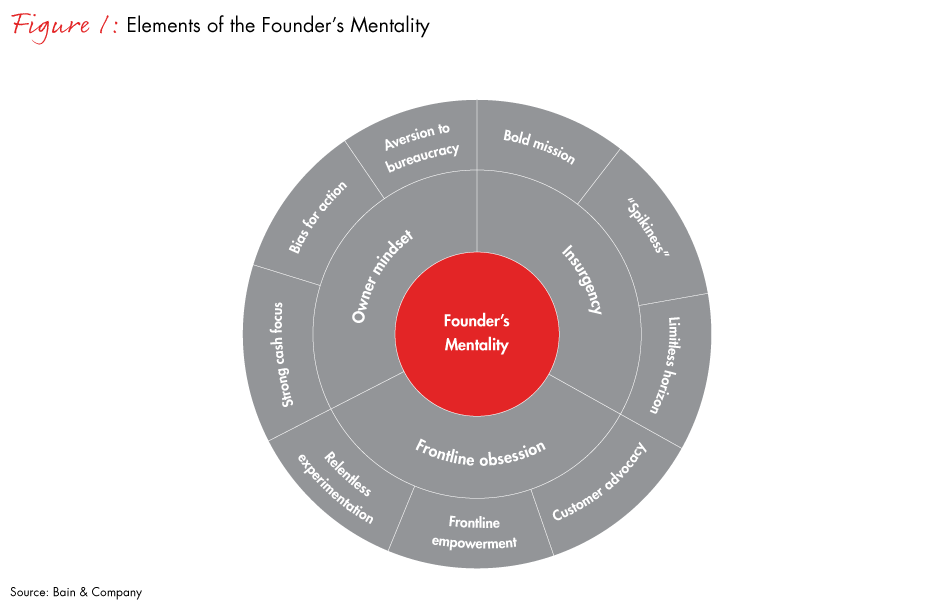
But as companies move along the default path from insurgency to incumbency (see Figure 2), they trade their Founder’s Mentality for the benefits of size. This trade-off seems positive for a while—after all, size matters in business. But once the culture tips toward a more bureaucratic, incumbent mindset, the leaders of these big companies face a huge problem: Their size becomes more burden than asset, and a new generation of insurgents begins picking off their underserved customers. Slowly, these companies slide from incumbency to struggling bureaucracy. They don’t die fast because they have strong core businesses that can generate profits even in a lousy culture. But it ain’t a lot of fun to work there, and they begin losing the war for talent. Some of you work for companies such as these and can attest that it doesn’t feel great.
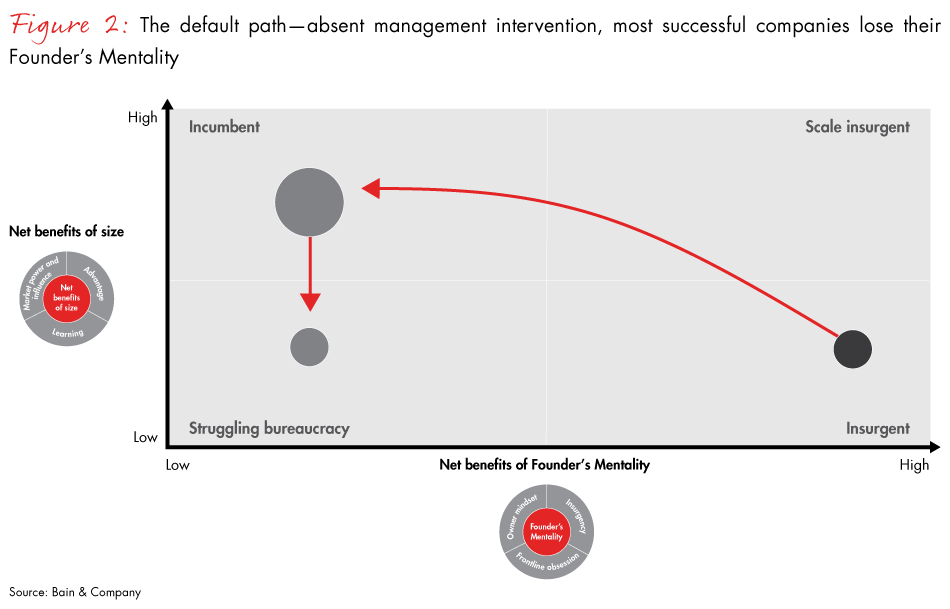
We’ve invested a huge amount of time identifying the forces that pull companies off track, and our key message is that there are eight “winds” that hold back all companies. It’s important to note, however, that the forces that blow you toward the default path aren’t personal or political; they’re the result of your growth.
By managing these winds effectively, some incumbents and struggling bureaucracies recover, and some insurgents avoid the drift to incumbency. The most successful leaders turn their companies into scale insurgents by creating teams that embrace the benefits of Founder’s Mentality and the benefits of scale. These stories are at the heart of our book The Founder’s Mentality, and we’ve been working with dozens of CEOs on how to start their journey toward scale insurgency. The most successful deploy six building blocks.
- Rediscover the insurgency and capability spikes to accelerate growth. The key concepts here are “insurgency on a hand” and a “compass.” The goal of the former is to translate your strategy into the language of the front line (biological constraints force you to simplify). Your thumb is a statement of your insurgent mission (in customer-focused language), and your fingers represent the three or four spiky capabilities that help you deliver that insurgent mission. The goal of the compass is then to translate that simple but powerful insurgent mission into 10 to 12 “nonnegotiables.” These are the must-do frontline routines and behaviors that everybody commits to doing every time, every day. One CEO argued that this process helps recover the common instincts that defined team behavior in the firm’s early days.
- Build Engine 2 to challenge industry rules and boundaries. The key here is to recognize that sustainable growth demands working through the Engine 1/Engine 2 challenge. Engine 1 is your current core business. It returns significant capital because you lead and have invested in it for years. But it may not be future-proof. Engine 2 may be your future source of revenue—new businesses with the potential for rapid growth, but also characterized by turbulence and lousy short-term economics because you need to invest ahead of revenue. Or it may be where you choose to experiment with a new future-proof business model to better serve your existing core. Every company needs to figure out the right organization and investment strategy to manage Engines 1 and 2, but most make one of the following mistakes. First, many companies delay major Engine 2 investments until they see a significant reduction in Engine 1 performance or their current business model starts to show cracks. This is a problem because the new business or business model may take years to build, which means you have to invest well ahead of time. The second mistake is postponing the major Engine 1 cost- and complexity-reduction programs that free up the necessary funds for Engine 2. Companies do this because they think about strategy based on last year’s revenue and overweight Engine 1’s need for resources. The key is to look forward and allocate resources to where you expect growth over the next decade.
- Refocus the operating model on “franchise players.” The modern firm is dominated by the professional managerial class, and a cynic would argue that incumbent leaders spend most of their time serving this group’s interests rather than the interests of customers. The antidote to this inward focus is to identify your franchise players and reorient the enterprise around them. Franchise players are the mission-critical people who deliver the insurgent mission to customers every day—either by providing the benefits of intimacy (roles devoted to local, close customer contact) or size (roles that focus on lowering costs through global scale). Franchise players are frontline people, but they also fulfill the critical functions that deliver spiky capabilities through scale. Many business leaders don’t know who their franchise players are—and when they do identify them, they often find them buried beneath layers of bureaucracy, making it nearly impossible for them to deliver the insurgent mission to the company’s most important customers. It’s critical to liberate them.
- Build learning systems to reconnect with customers and the front line. We talk about learning as a core benefit of getting bigger, but the truth is that very few companies actually have world-class learning systems. They assume that getting bigger results in experience-curve benefits, but they do nothing to enable this. In essence, they’re ignoring the one massive competitive advantage of size: superior learning. The best learning system is the Net Promoter System®. Get acquainted with it.
- Simplify to fuel growth. Leaders should constantly review the resources under their control and try to figure out how to do more for less. They should then look for unneeded resources and reallocate them to fund new growth opportunities in or out of their control. Of course, leaders rarely do that, because all bureaucratic training teaches you to hold resources in reserve and to measure your worth by the size of your empire. To create an owner mindset (in which folks see every resource as the firm’s resource and work to apply it to the highest and best use) demands a profound cultural shift.
- Create a company of insurgents. Companies don’t win through processes or systems alone; they win through the heroics of their people. Whom you reward and the stories you tell about heroes define the company you want to be. Do you regularly reward the folks who do whatever it takes to solve customer issues and who fight against the stupidities of bureaucratic decision making? Or do you signal every day that the way to get ahead is to keep your head down and rise through the professional managerial class slowly and carefully by mastering the politics? When you start to look deeply into your recruiting and development programs, you’ll be shocked—you’re most likely creating incumbents, not insurgents.

Micro-battles
Want to learn more about the journey to scale insurgency? Explore the Bain Micro-battles System℠, step by step.
The Micro-battles System
The six building blocks set out the “what”—what do we need to do to become a scale insurgent?—but equally important is the “how.”
Leaders of large companies face a dilemma: They agree completely with the ambition to become a scale insurgent, but they are, by definition, an incumbent or a struggling bureaucracy because the leaders have an incumbent or bureaucratic mindset. The leaders participated in the drift—we got ourselves into this mess, and business as usual isn’t going to get us out of it. The act of deciding to become a scale insurgent is implicitly a declaration of war on the routines and behaviors of the leaders themselves.
We’ve worked long and hard on this problem over the past five years and believe that deploying the Micro-battles System (see Figure 3) is a highly effective way to pursue the what (building blocks) while shaking up everything in the how. It’s a way to start winning again in the marketplace, and it’s a way to pursue deep behavioral change as you begin to act as a scale insurgent. It’s surgical. We’re going to bring change one micro-battle at a time. But the reason we’re doing this is because business as usual will fail.
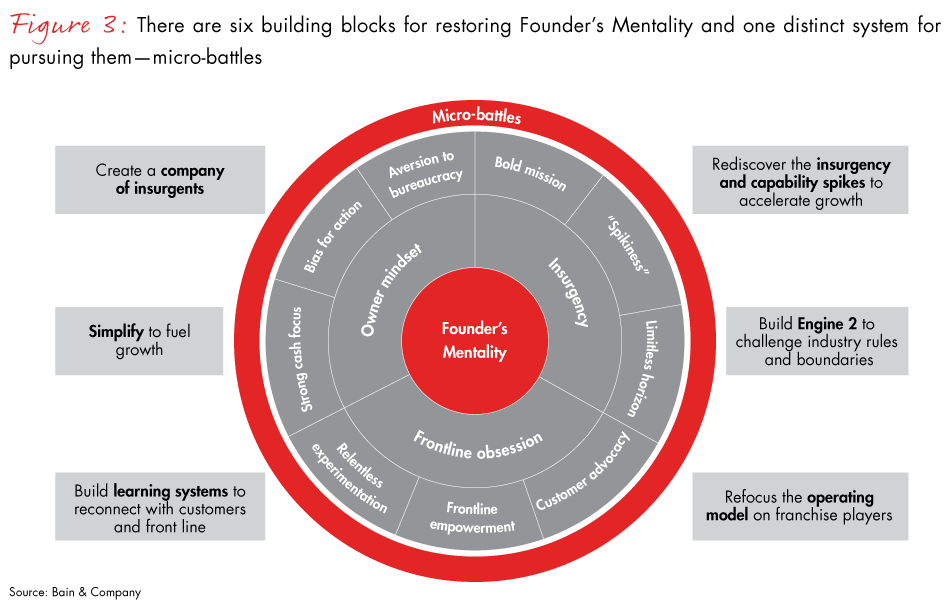
The best way to explain what we mean by a micro-battle and the Micro-battles System is to start with a couple of good examples.
Business to consumer (B2C): Let’s say you’re a global beer company called Bedrock Enterprises (BE). Your biggest premium brand is Fred’s Grog (a nod to the Flintstones), and it competes with all the top brands. Similar to any self-respecting global company, BE has a strategic priority to “win in China,” and that will require lots of things to go right: BE must hire a good sales team, it must acquire a bunch of Chinese beer brands to get distribution scale, it must deal with Chinese regulators and so on.
What you realize, though, is that these are all enabling activities. The thing that will determine BE’s ultimate success in China is making Fred’s Grog the No. 1 import brand, and that will require winning in the on-trade channel (bars and the like). To conquer the on-trade channel, BE will need specific promotions in the trendiest bars that outperform all other imported beers on the preference drivers of aspirational consumers (namely, the folks whom everyone else wants to be like). That’s a mouthful, I know, but you see how we’ve moved from the vague idea of winning in China to a specific need to get promotions right with specific consumers in specific bars.
And there’s more. What capability are we trying to build with this micro-battle? And how are we going to scale this battle? The leadership team of BE has choices. They could logically argue that since the micro-battle is all about winning in China, the best scaling strategy is to apply their learning in on-trade channel promotion to BE’s portfolio of other brands in China. But they might also take a broader approach. Let’s assume in this case that BE management decides to scale this micro-battle by taking the model proven in China to other emerging-market countries, starting in Nigeria and India. The real strategic priority, then, becomes “win in emerging markets,” not “win in China.” To create an approach that is transferable to India and Nigeria, the BE team decides to add on-trade specialists from India and Nigeria so they can constantly test the prototype for transferability. What you see here is that a micro-battle is no small thing; it’s an extremely focused initiative that starts with the hardest problem first and iterates on the solution. Micro-battles are all about fast failure and adaptation. But as we’ll see, the key is low-cost failure—you’re trying to make cycle times so fast that you limit the cost of failure on each cycle of learning.
Business to business (B2B): We can be briefer with this second example. Let’s assume we have a complex trucking company called Transport Co. Transport has just bought several major warehouse companies that own lots of distribution centers. It has also acquired a major online player that creates B2B digital platforms to handle ordering and fulfilment. Strategically, Transport wants to be more of an end-to-end logistics player, with both trucking and warehouses, and it knows it needs to tie it all together with a robust digital customer experience. Organizationally, all these moves will demand that Transport go through a huge reorganization around customer segments on one hand and create a single end-to-end logistics function on the other.
Typically, this kind of transformation takes years of complex organizational rewiring, with lots of internal focus and bureaucratic infighting. But Transport management takes a different approach: For each of our five new customer segments, the company decides, we’ll launch a micro-battle to gain 100% share-of-wallet from the best-in-class player in that segment. In sports and apparel, for example, the battle will focus on capturing the entire end-to-end logistics business of the leader in that segment.
The goal of this micro-battle and the four others similar to it, however, is more ambitious than that. The ultimate objective is to use these battles to figure out how to act like the Transport of the future. Transport will learn to work with each of its top five customers as a truly integrated logistics company, even if the broader company isn’t there yet organizationally. So yes, we’ll continue with some horizontal initiatives to reorganize companywide, but these five micro-battles will ensure that for our five most important customers, we’ll remain externally focused and Agile. We’ll do whatever it takes to organize to serve them and test what the Transport of the future can be.
Defining a micro-battle
With those examples in mind, let’s agree on a standard micro-battle definition:
- Micro-battles are discrete time-boxed initiatives that rapidly bring strategic choices to action and aim to deliver speedy results.
- Micro-battles are run by small, cross-functional teams of seven to nine people, preferably dedicated full time.
- They are led by a franchise player, who owns the results.
- The team brings together the benefits of customer intimacy (front line) and benefits of scaling (the functions).
- Each team includes a process owner, who understands the principles of Agile innovation and can help the team unlock problems to be more effective.
- Every micro-battle has clearly defined deliverables around developing a winning prototype that can scale. This demands the company develop a clear thesis on key battlefields and what capabilities need to spike.
- Teams are empowered to progress and make recommendations, with a clear process to:
- collect customer feedback to adjust the prototype; and
- gather input from a defined set of stakeholders (including senior leadership).
- Teams are devoted to test and learn. They’re willing to fail fast and adapt.
The ultimate goal of micro-battles is to teach your organization to act like a scale insurgent. Because of this, each micro-battle should look like a microcosm of the organization you want to become. This demands a system to maximize learning, focusing on the behaviors of two types of teams:
- Win-Scale: The individual teams running individual micro-battles. They test and learn on three- to four-week cycles.
- Amplify: The Leadership (Amplify) team at the corporate center that is running the portfolio of micro-battles as part of its overall strategy to become the industry’s scale insurgent. They support individual micro-battles and manage the portfolio.
Let’s explore how each team should work and the broader capability building and behavioral change we’re trying to engineer.
The Win-Scale team
Think Agile—as in using Agile development methodologies to guide micro-battle activity. The emphasis is on winning (solve the specific by ruthlessly focusing on fast failure) and on scaling (ensure that your solutions can be spread across the company). By definition, there’s a tension between winning (make it smaller) and scaling (make it bigger). The skill to manage this tension is a critical capability of a scale insurgent. There are four steps to getting there (see Figure 4).
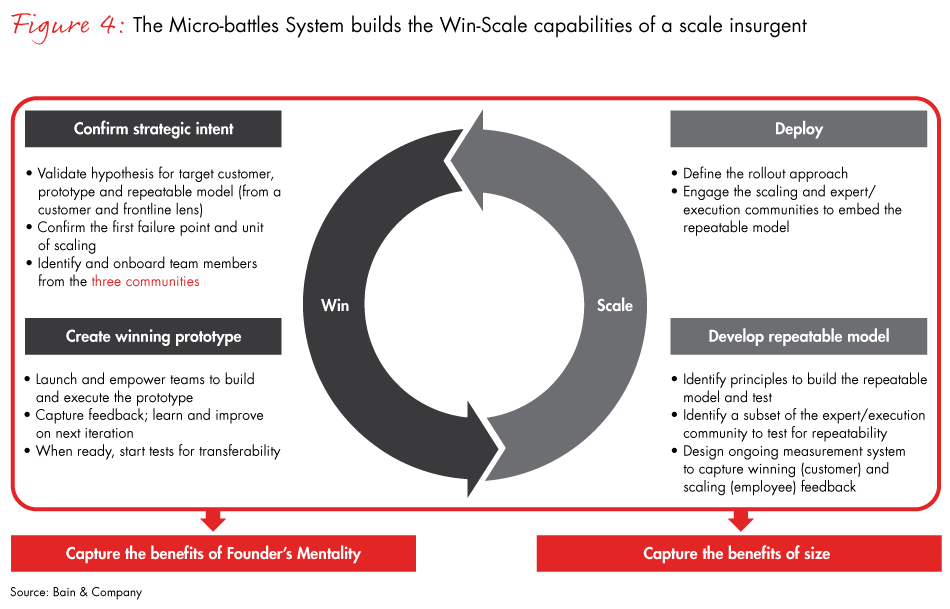
Step 1: Confirm strategic intent. This includes validating the first failure point and desired repeatable model for the micro-battle. Let’s start with first failure point. Think back to our first example. The critical first step was sharpening the ambition from “win in China” to “beat every other import brand with Fred’s Grog in the on-trade channel.” The goal is to confirm the essential thing that will determine the success of the strategy, and figure out how to market test that thing in four-week cycles, using fast failure to hone a prototype.
Strategically, it takes a lot of wisdom to move from big strategic objectives to first failure points (which can then be prototyped). And you’ll discover that some of your leaders lack that wisdom, which might explain the tremendous yield loss when moving from strategic intent to results. But you’ll also discover new leaders emerging who can do this brilliantly. Operationally, you’ll need to break a lot of eggs. Your teams and third-party partners aren’t geared up for four-week cycles of anything.
In addition to confirming the first failure point, you must also validate the hypothesis of the repeatable model you’re trying to create. Think back to our example again: Are you trying to find new ways of winning with all brands in China, or are you trying to create a way to win with your premium brand across multiple geographies? This discussion about what you test and what your repeatable model should be will be an iterative process. With each new market test, you’ll improve the prototype and gain greater clarity on the repeatable model.
Step 2: Create winning prototype. We expect micro-battle teams to create a winning prototype for the specific situation (winning in bars in China). We want the team to work fast and introduce a new concept to the customer on a three- or four-week cycle. This will stretch not only your team, but also the partners you use. Initiatives such as the trade promotion programs in the Fred’s Grog example typically take months to design and execute, so this step demands that you shake up your ways of working. You need to accept fast failure by focusing on prototypes that you can test quickly with customers, learn from, adapt and then retest. You’ll fail a lot anyway, but most of your failure happens toward the end of big initiatives because your teams put off the hard stuff. Our goal is to accelerate learning and innovation while also reducing the cost of each failure. You’ll need to have tough discussions with your partners to ensure they can work in new ways as well.
Step 3: Develop repeatable model. This third step is completely in conflict with the second step, and that’s a great thing. In Step 2, the team leaders help the team “make the problem smaller.” Yes, we could do 100 things with each prototype, but what are the one or two things we need to do in this cycle, to test and learn? The goal is speed. Speed demands we focus and simplify. But Step 3 is all about making sure the prototype is scalable. This means we’ve tested the prototype for transferability (it works in more than one situation—across channels, customers, and so on) and we’ve tested the prototype for repeatability. “Normal” teams at “normal” staffing levels in a “normal” day can achieve the same results.
This step separates micro-battles from pilots done badly. We know the drill. You pilot something with your best resources, endless senior management attention and support, and lots of time. Lo and behold, it works. Then you try to roll out the pilot across the enterprise and it fails. Why? Because you declared victory before you tested the pilot for transferability and repeatability at normal resource levels.
The tension between Steps 2 and 3 is purposeful and defines the behavior of scale insurgents. You want your leaders to struggle with getting the next prototype out the door while thinking about how that prototype can be “industrialized across the enterprise” (that’s one CEO’s description of this tension). In Step 2, we make things simpler to test. In Step 3, we make things more complicated to ensure we have a scalable solution. Step 2 is about winning. Step 3 is about beginning the journey toward scaling.
To help alleviate this tension, populate teams with folks who will be involved in the next phase of the rollout from the beginning, not at the end, of the test phase. Here’s an example: You want what works in China to work in Nigeria and India. In the typical incumbent company, if you figure out a winning formula for China and then pass it along to your Nigerian and Indian teams, they often reject it immediately. They complain that the channel structures, competitive sets and team capabilities are completely different. The model is unusable. You then spend a huge amount of time fighting about this, and questions of “corporate citizenship” emerge—the center accuses the local teams of not being good citizens, of not getting with the program, of not accepting things that haven’t been invented by them. Huge political angst. With micro-battles, you bring someone from Nigeria and India in early to co-create the prototype. They have to win in China first, but they also have to challenge the team on how to make the model work elsewhere. In that process, the team may very well conclude that the winning Chinese prototype will work in India, but not Nigeria. That is data. It might lead to another micro-battle for Nigeria and countries with similar market characteristics.
Step 4: Deploy. Finally, the team must deploy the repeatable model across the organization. This demands that they map out the behavioral change required to embed the repeatable model. In our Fred’s Grog example, the team might very likely learn that the global Fred’s Grog brand team needs to move from headquarters into the field if the model is going to click. It might recommend that global brand owners need to work with key account managers for bars on an ongoing basis to be able to adapt promotions quickly. And the company’s marketing agency partners might not be up to the task of fast prototyping, which means the team needs new partners. The team might also need new capabilities to create prototypes—especially for labels and bottle sizes. The idea is to work through all the potential obstacles for scaling the repeatable model.
The Leadership (Amplify) team
Up to this point, we’ve talked about the key steps the micro-battle team must follow. Now we’ll turn to the senior leadership team. It’s their job is to amplify the results of the micro-battle teams by supporting individual micro-battles and managing the portfolio. In fact, the Leadership team has five specific roles as it helps micro-battle teams (see Figure 5). These are:
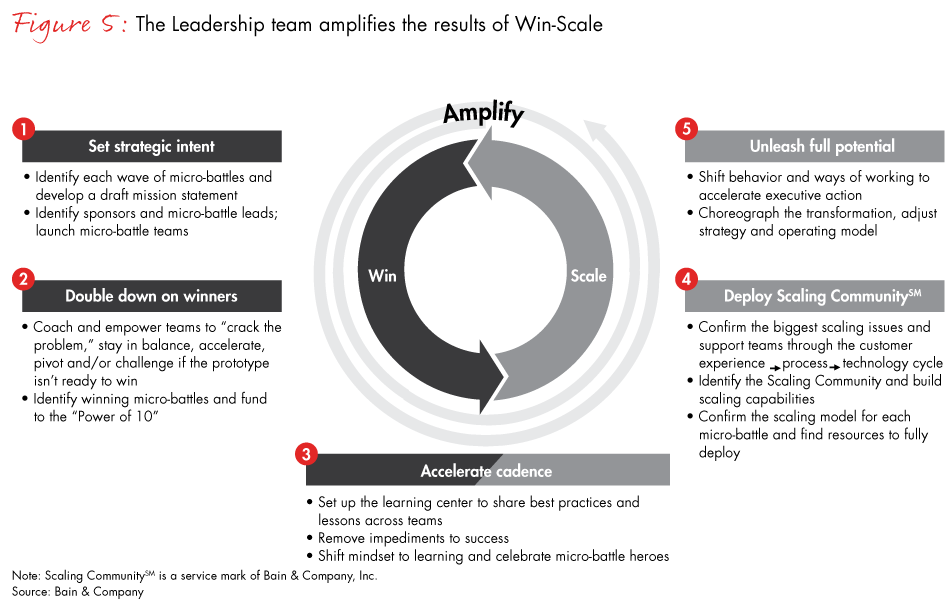
Step 1: Set strategic intent. The Leadership team must translate the firm’s strategy into waves of micro-battles and form the right teams to lead these battles. To be clear, not all strategic initiatives lend themselves to micro-battles. Those that are “vertical” by nature (in other words, they translate strategy into a frontline routine that helps customers) and could benefit from innovative, market-tested solutions make good battles. Separately, we’ll talk about how to choose your first wave of micro-battles and scale up the portfolio.
Step 2: Double down on winners. Micro-battle teams are fully empowered to run their own battles. But in their first year, we recommend that the senior team review progress roughly every three to four weeks. There are three critical reasons for this review. The first is to support micro-battle teams when they encounter problems. These teams are moving fast. They’ll need the rest of the organization to keep pace. The senior leaders will help make this happen. The second is to accelerate the results of winning teams. We refer to this as the “Power of 10.” Once you have a repeatable model that’s getting results, the Leadership team needs to ask “What if we gave them 10 times the resources? How much more could they achieve?” The third reason for review meetings is more subtle—the interactions of the senior team with micro-battle teams will lead to behavioral change. And let’s be clear, the behaviors that need to change are those of the Leadership team. Remember, we started this discussion with the idea that micro-battles are about rediscovering the art of getting things done fast. This art is typically lost by the senior team first. We’re asking the micro-battle teams to help your team change its behaviors. It’s a big ask of these teams, who would happily soldier on without you. But we need them to help you.
Step 3: Accelerate cadence. We refer to the meeting room where the senior leaders meet with micro-battle teams as the “learning center.” We want the Leadership team to learn from each micro-battle and pursue pattern recognition. As you address bottlenecks, what common strategic issues are your teams facing? What about organizational issues? Are you missing key capabilities? Are you learning about common problems of scaling? Are you doing enough to recognize the new heroes emerging from micro-battles? Are there issues with your culture or ways of working that you should address? With these questions, you’ll identify the broader actions that you can take to help micro-battle teams accelerate their impact. You’re trying to increase the metabolic rate of your company. Or, in other words, your cadence.
Step 4: Deploy Scaling CommunitySM. While Step 3 identifies different actions you can take to amplify the impact of micro-battles, Step 4 focuses on one specific action that must be taken. From Day 1, the Leadership team needs to focus on the task of building the Scaling Community and effectively deploying it across micro-battles (see “The role of the three communities.”). From Day 1, the Scaling Community needs to work on fixing key business processes and finding technology solutions for each micro-battle. There’s a methodology to help with this. We call it the “three levels” of micro-battles. In almost every micro-battle, level one is the “customer experience”—ultimately, your repeatable model will change some aspect of your customer experience. Once you understand what that will be, you move to level two. To improve the customer experience in Area Y, what are the core business processes that you must change before you can scale the innovation? Please note that this isn’t a wholesale change of business processes. This is a very focused exercise to identify a small set of changes required to enable a better customer experience in Area Y. Now you move to level three. Having identified the business process changes, the team asks, “What technology changes can we make to improve these business processes to create a better customer experience in Area Y?” Again, this isn’t a technology initiative per se, but rather a focused intervention. You’ll work out how technology will accelerate the benefits you’re seeking. In building a Scaling Community and helping it become great at working with the micro-battle teams on the three levels, you’re rediscovering the art of getting stuff done fast.
Step 5: Unleash full potential. The Leadership team needs to regularly revisit the company’s strategy and ask questions like, “What are we learning about these micro-battles that will help us achieve our full potential as a company?” “In thinking through the choreography of transformation, do we have the right blend of vertical and horizontal initiatives?” “Do we need to do more with our senior team to change behaviors?” “Do we need a broader intervention on culture or ways of working?” We interchangeably call our leaders the Amplify team, because at every step, you’re asking the team to consider how to get even more out of the micro-battles results. In this last step, you’re simply asking, “What else do we need to do to drive to full potential across the enterprise?”
There’s one final thing to note. In all five of these steps, the Leadership team has another role: to be the role model for the behaviors of a scale insurgent. The micro-battle teams will be judging your team on its interactions with you. They want to know, “Are we meeting with a group of executives that’s helping us amplify our results, or is the team impeding us?” There are many antonyms to the word amplify, and it’s worth reviewing them. They include: decrease, weaken, curtail, diminish, halt, lessen, lower, narrow, reduce, shrink and stop. Your Amplify team must understand that if it isn’t helping the micro-battle teams amplify their results, it’s most likely doing the opposite. When this happens, your best people will tell the world that their initiative has been weakened or diminished, reduced or stopped. Role modeling is critical for every member of your Amplify team. If they can’t role model the behaviors of a scale insurgent, they shouldn’t be on your Amplify team.
The role of the three communities
Micro-battle teams must be masters of winning and scaling. They must be able to adopt fully Agile ways of working to pursue fast prototyping. They must also worry about how to scale those innovations across the enterprise and develop a repeatable model. They must be masters of disruption. They must be masters of scalable execution.
It’s almost impossible to imagine any one leader with all those skills. It’s difficult to imagine a team of people with all those skills. This explains why, in our view, so few Agile initiatives successfully scale. It’s really hard to translate disruptive ideas into initiatives that can be industrialized across the enterprise at normal resource levels.
As we’ve worked with scores of business leaders on this topic, we’ve concluded that successful scaling of innovation demands that we identify and nurture three separate communities (see figure). These are:
- The Agile/disruptive/innovator community. These are the innovators, who disrupt products, services, business processes and sometimes, the business model itself. They must learn Agile ways of working and develop the skills to prototype quickly, testing and learning as they go. Scalers may create 40% to 50% of the firm’s value going forward. They are critical; it’s no wonder everyone talks about bringing Agile into their companies.
- The expert/execution community. These are the doers. They’re the ones that deliver to our customers, make our factories run, and get our products from the factory to the warehouse to our distribution partners. In a company with strong Founder’s Mentality, they’re the heroes, because the leaders value great execution above all else. They make up roughly 85% of the activity of the firm. They rely on playbooks. They have fixed routines and common behaviors. Consider this: When you board a plane, you don’t want to hear the pilot say, “Welcome to this Agile flight. We’ll be testing new ways of landing today and learning quickly from our mistakes.” No, you want the pilot to say, “Welcome to our execution team. We have a set of checklists and guidelines based on the entire history of aviation and its lessons. We won’t deviate from these well-established ideas, because we want to keep you safe.”
- The Scaling Community. We call this the “missing community.” It’s the critical bridge between innovative prototypes and industrialized solutions that can be incorporated into the playbooks, routines and behaviors of the execution community. It’s the bridge between winning and scaling. And yet, no one is talking about this community. No one’s building it, nurturing it or asking key members to help with Agile innovation. And yet it plays a critical role in micro-battles.
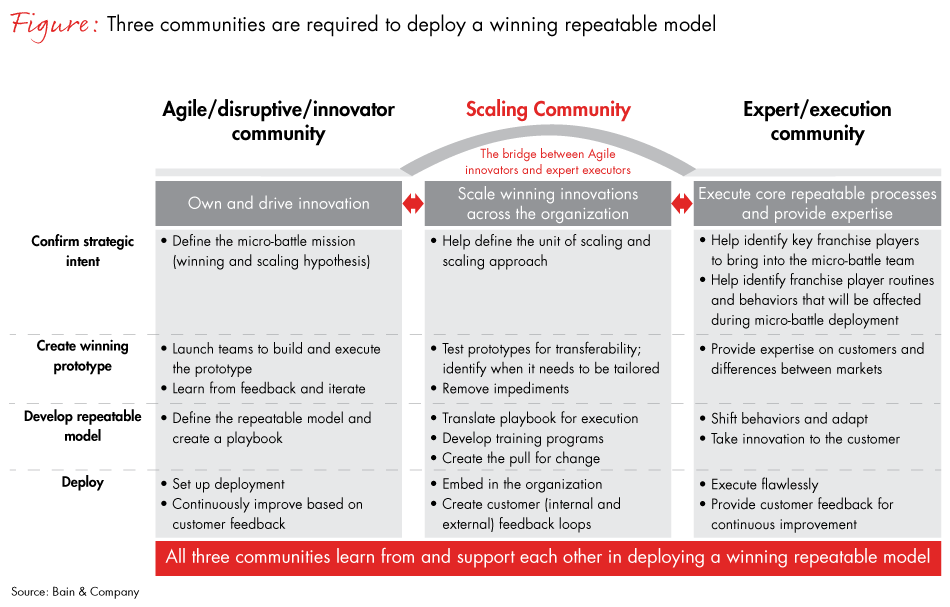
The job of the micro-battles team is to mobilize these three communities during the four key steps of winning and scaling. The leaders of micro-battle teams must reach out to members of each community to get help in prototyping, developing Repeatable Models® and deploying new solutions across the enterprise. But, these communities have to exist! It’s up to the Leadership team to bring the members together and nurture these communities.
Walk before you run
That’s the heart of the Micro-battles System. There is, in fact, much more to it. We’ve identified a list of the core activities that typify how scale insurgents put the system in motion, and we’ll discuss each one in these blogs (see Figure 6).
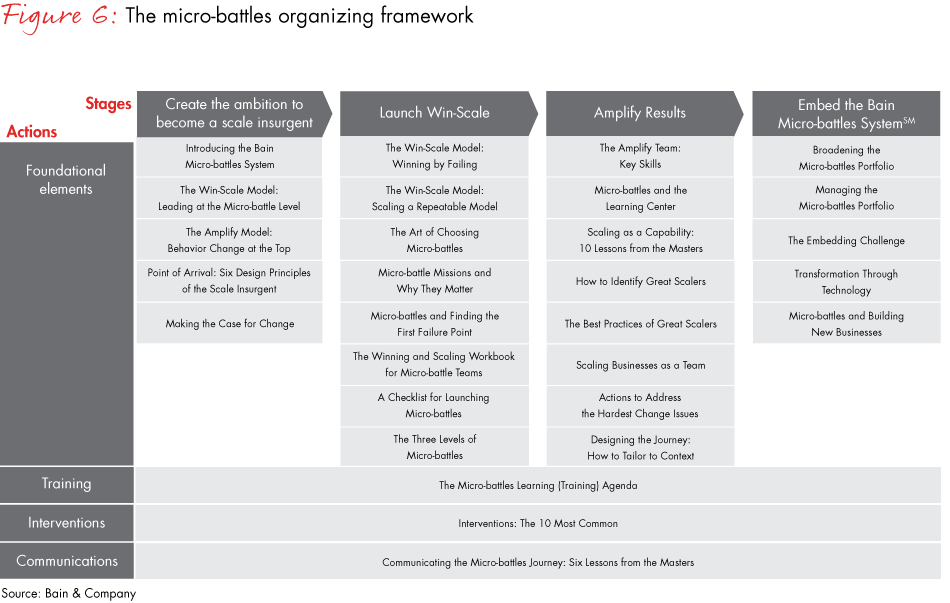
But the good news is that you can walk before you run. Commit to launch three micro-battles now. That’s it. Agree to carve out three hours of a monthly executive meeting to review the cycle results of those three battles. Mobilize your micro-battle teams to learn Win-Scale. Mobilize your senior leaders to act as the Amplify team. Learn through four cycles and then launch three more micro-battles, followed by four more weeks. Then six more battles. Then 12 more. Quickly, you’re more than a year into learning. You’re finding that your micro-battle reviews take all day. You’re focusing less on functional reporting and more on marketplace battles. You’re spending less time as an executive team talking to each other and more time listening to the voices of your customers and franchise players. You’re backing winning Repeatable Models and succeeding in the marketplace. You’re focused on deep behavioral change. You’re on the journey to becoming a scale insurgent.

The Win-Scale Model: Leading at the Micro-Battle Level
The objective of the Win-Scale model is to run the micro-battle like the company you want to become—namely, a scale insurgent.
Bain Micro-battles System℠ is a service mark of Bain & Company, Inc.
Founder’s Mentality® is a registered trademark of Bain & Company, Inc.
Net Promoter System®, Net Promoter Score®, Net Promoter® and NPS® are registered trademarks of Bain & Company, Inc., Fred Reichheld and Satmetrix Systems, Inc.
Great Repeatable Models® and Repeatable Models® are registered trademarks of Bain & Company, Inc.
Scaling Community℠ is a service mark of Bain & Company, Inc.